Science Olympiad Previous Year Questions - 1 | Science Olympiad Class 4 PDF Download
Note: The questions provided in this document are similar to the questions that were asked in the actual Olympiad exam. So, we recommend you study these for your Olympiad preparation.
Logical Reasoning Section
Q1: Select the figure from the options which when placed in blank space of Fig. (X) would complete the pattern.
 (a)
(a) 
(b) 
(c) 
(d) 
 View Answer
View Answer 
Ans: (b)

Q2: How many curved lines can be found in the word 'B'?
(a) 2
(b) 3
(c) 4
(d) More than 4
 View Answer
View Answer 
Ans: (a)
There are 2 curved lines in the word 'B'.
Q3: Which of the following options will complete the given number pattern? 75 70 64 57 ? 40 30
(a) 45
(b) 49
(c) 55
(d) 42
 View Answer
View Answer 
Ans: (b)
- The pattern starts at 75 and decreases by 5, then 6, then 7. The differences are 5, 6, 7.
- Following this pattern, the next difference should be 8. So, 57 - 8 = 49.
- The next number in the sequence is 49, which fits the pattern perfectly.
- Thus, the correct answer is (b) 49.
Q4: The positions of the first and the second digits in the number 94316875 are interchanged. Similarly, the positions of the third and fourth digits are interchanged and so on. Which of the following will be the third to the left of the seventh digit from the left end after the rearrangement?
(a) 1
(b) 4
(c) 6
(d) 3
 View Answer
View Answer 
Ans: (d)
After interchanging the digits, we get 4 9 18 657 7th digits from the left end is 6 and 3rd to the left of 6 is 3.
Q5: In a specific coding system, HERO is represented as $17 and POLO is represented as 2@3@. How will HELP be represented in this coding system?
(a) $132
(b) $7@3
(c) $312
(d) @$13
 View Answer
View Answer 
Ans: (a)
- The code for HERO is $17, where H=8, E=5, R=18, O=15. The sum of the positions of H and E is 8+5=13, and R and O is 18+15=33. The code combines these values in a specific way.
- For POLO, the code is 2@3@, indicating a different pattern. The letters P, O, L, O correspond to their positions in the alphabet.
- To find HELP, we calculate H=8, E=5, L=12, P=16. The code for HELP will follow the same pattern as HERO, leading to the representation $132.
- Thus, the correct code for HELP in this language is $132.
Science Section
Q6: Refer to the given flowchart and select the INCORRECT option regarding plants P, Q and R.
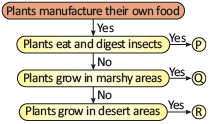 (a) P generally grows in soil that is deficient in minerals like nitrogen.
(a) P generally grows in soil that is deficient in minerals like nitrogen.
(b) Q has special roots that grow above the soil to breathe air.
(c) Leaves of R may possess sunken stomata or may be reduced to spines.
(d) None of the above.
 View Answer
View Answer 
Ans: (d)
All the given statements are correct. The plants that grow in nitrogen deficient soil eat and digest insects to fulfil their nitrogen requirement. The soil in marshy areas is full of water and there is no air trapped in soil, so, the roots grow above soil to breathe in air. The plants in desert areas have sunken stomata or leaves reduced to spines to prevent loss of water.
Q7: Rubina took a piece of fabric and burnt it. On burning, it gave the smell of burning celery. This fabric could be made from
(a) Cotton
(b) Wool
(c) Nylon
(d) Linen
 View Answer
View Answer 
Ans: (c)
- The fabric that Rubina burnt produced a smell similar to burning celery. This is a key indicator of the type of material.
- Nylon is a synthetic fabric that, when burned, emits a smell reminiscent of burning celery, which is a distinct characteristic.
- In contrast, cotton and wool have different burning smells, while linen does not match this description either.
- Thus, the correct answer is Nylon, as it aligns with the observed burning smell.
Q8: Which of the following plant groups possesses a root system similar to the one shown in the given figure?  (a) Grass, lichi, wheat
(a) Grass, lichi, wheat
(b) Mango, bean, pea
(c) Wheat, rice, oat
(d) Pea, maize, wheat
 View Answer
View Answer 
Ans: (b)
These plants have tap root system.
Q9: Select the INCORRECT match.
(a) Mangrove : Breathing roots
(b) Cactus : Photosynthetic stems
(c) Venus flytrap : Roots trap insects
(d) Tape grass : Ribbon like narrow leaves
 View Answer
View Answer 
Ans: (c)
The leaves of Venus flytrap help in trapping insects.
Q10: Tree X grows in desert and has small leaves to prevent water loss through transpiration. Identify X.
(a) Sugarcane
(b) Acacia
(c) Mango
(d) Water lily
 View Answer
View Answer 
Ans: (b)
- Acacia is a type of tree that is well-adapted to dry environments like deserts.
- It has small leaves which help reduce water loss through a process called transpiration.
- This adaptation is crucial for survival in arid conditions where water is scarce.
- Other options like Sugarcane, Mango, and Water lily do not have the same adaptations for desert survival.
Q11: Which of the labelled arrows correctly rep-resent the movement of water in and out of the leaf?

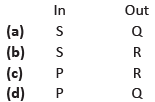
 View Answer
View Answer 
Ans: (c)
The water absorbed by roots is transported through stem and the excess water is lost to atmosphere through stomata present on leaves.
Q12: Select the odd one out based on types of simple machines.
(a) See-saw
(b) Pliers
(c) Claw hammer
(d) Screwdriver
 View Answer
View Answer 
Ans: (d)
- The see-saw is a type of lever, which is a simple machine used to lift or move loads.
- Pliers are also a type of lever, designed for gripping and bending objects.
- The claw hammer functions as a lever as well, primarily used for driving nails.
- However, the screwdriver is not a lever; it is a tool that turns screws, making it the odd one out.
Q13: Identify the part labelled as ‘X’ in the given figure. 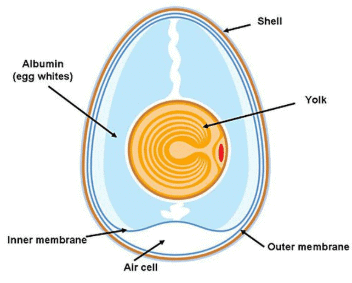
(a) Yolk
(b) Air space
(c) Albumen
(d) Embryo
 View Answer
View Answer 
Ans: (b)
- The part labelled as ‘X’ refers to the Air space in the figure of an egg.
- The Air space is located at the larger end of the egg and forms as the egg cools after being laid.
- This space is important for the developing embryo as it provides oxygen during incubation.
- Other options like Yolk, Albumen, and Embryo refer to different parts of the egg, but do not represent the air space.
Q14: Which of the following sequence shows the correct order of stages in a plant’s life?
(a) Young plant → Seed → Adult plant
(b) Seed → Adult plant → Young plant
(c) Adult plant → Young plant → Seed
(d) Seed → Young plant → A dult plant
 View Answer
View Answer 
Ans: (d)
The seed grows into young plant and then to adult plant.
Q15: Trees start as seeds and grow into mature trees that produce more seeds. This pattern represents a _______________.
(a) Food chain
(b) Life cycle
(c) Food supply
(d) Life span
 View Answer
View Answer 
Ans: (b)
Life cycle is the circular process of how life continues and progresses from one generation to the next.
Q16: The given figure shows the structure of a tooth. Select the correct option regarding labelled parts P, Q and R. 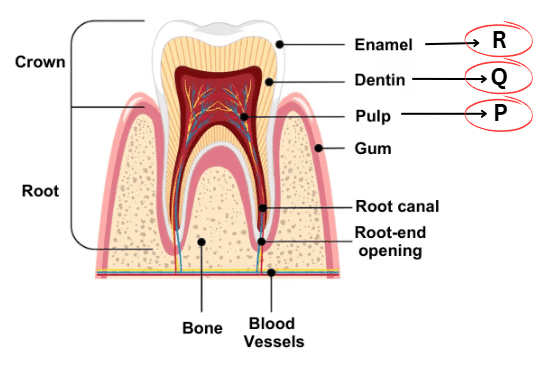
(a) R is the hardest substance of our body.
(b) Q is a material similar to bone that supports R.
(c) P contains nerves and blood vessels.
(d) All of these
 View Answer
View Answer 
Ans:
- R is indeed the hardest substance in our body, known as enamel.
- Q refers to dentin, which is a bone-like material that provides support to enamel.
- P is the pulp, which contains important nerves and blood vessels that nourish the tooth.
- Since all statements about parts P, Q, and R are correct, the answer is All of these.
Q17: Select the correct option regarding Do’s and Don’ts.
(a) Always keep the bathroom floor wet / Keep the soap in the soap case when not in use
(b) Leave your toys on the floor after playing / Handle glass objects carefully
(c) While walking, cross the road only at the zebra crossing / Run around the class corridor
(d) Wear only synthetic clothes while working in the kitchen / Touch electrical appliances with wet hands
 View Answer
View Answer 
Ans: (c)
- Option (c) is correct because it emphasizes safety by stating to cross the road only at the zebra crossing, which is a designated area for pedestrians. This helps prevent accidents.
- The other options include unsafe practices, such as leaving toys on the floor, which can cause tripping, or touching electrical appliances with wet hands, which is dangerous.
- Following the Do's and Don'ts is essential for maintaining safety and preventing injuries.
- Always remember to prioritize safety in daily activities.
Q18: In some trees, stems are thick but they are soft like ______________.
(a) Banyan
(b) Banana
(c) Coconut
(d) Apple
 View Answer
View Answer 
Ans: (b)
Banana trees have soft and thick stems and bear fruit only once in their lifetime.
Q19: A ball is placed on the top of a high building. What kind of mechanical energy does it have?
(a) Kinetic energy
(b) Geothermal energy
(c) Potential energy
(d) Chemical energy
 View Answer
View Answer 
Ans: (c)
- The ball is on the roof, which means it is at a height. This height gives it potential energy.
- Potential energy is the energy stored in an object due to its position. In this case, the ball has energy because of its height above the ground.
- Kinetic energy would apply if the ball were moving, but since it is stationary on the roof, it does not have kinetic energy.
- Geothermal energy and chemical energy are not relevant to the situation of the ball on the roof.
Q20: Jantar Mantar in Delhi was constructed to forecast the time and movements of the Sun, Moon, and planets by _____________.
(a) Sawai Jai Singh
(b) Aryabhata
(c) Varahamihira
(d) Bhaskara
 View Answer
View Answer 
Ans: (a)
- Jantar Mantar is an astronomical observatory located in Delhi.
- It was built by Sawai Jai Singh, who was a ruler and an astronomer.
- The observatory was designed to help in predicting the positions of celestial bodies.
- Other options like Aryabhata, Varahamihira, and Bhaskara were also great astronomers, but they did not build Jantar Mantar.
Q21: Which of the following statements is/are INCORRECT regarding the parts labelled as X and Y in the given picture? 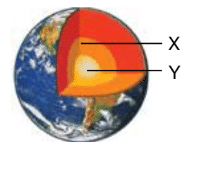
(a) X is a liquid layer.
(b) Copper and magnesium are the major elements present in Y.
(c) X is the thickest layer of Earth.
(d) Y is a solid layer.
 View Answer
View Answer 
Ans: (d)
- Y is a solid layer is incorrect because Y typically refers to the outer core, which is actually a liquid layer.
- X is a liquid layer is correct, as it usually represents the outer core.
- Copper and magnesium are not the major elements in the outer core; instead, it mainly consists of iron and nickel.
- X is the thickest layer of Earth is also correct, as the mantle is the thickest layer.
Q22: Banana plant grows from ___________.
(a) Underground stem
(b) Root
(c) Leaf
(d) Flower
 View Answer
View Answer 
Ans: (a)
- The banana plant develops from an underground stem, which is known as a rhizome. This structure allows the plant to grow and produce new shoots.
- Unlike typical plants that grow from seeds, the banana plant's growth is primarily from this underground stem, making it unique.
- The other options, such as root, leaf, and flower, do not serve as the primary growth point for the banana plant.
- Understanding this growth process is essential for recognizing how bananas propagate and thrive in their environment.
Q23: The primary role of down feathers is
(a) To keep the bird’s body cool
(b) To give shape to the body of bird
(c) To keep the bird’s body warm
(d) To assist the bird in maneuvering while flying.
 View Answer
View Answer 
Ans: (c)
- Down feathers are crucial for providing insulation to birds, helping to maintain their body temperature.
- These feathers trap air close to the bird's body, which is essential for keeping the bird warm, especially in cold environments.
- Unlike other feathers, down feathers are soft and fluffy, making them excellent for thermal regulation.
- Thus, the correct answer is (c) because their main function is to keep the bird’s body warm.
Q24: How many items in the following list are high in protein? Sugar, Tomato, Egg, Corn, Cabbage, Fish, Pulses, Ghee, Banana, Sunflower oil
(a) 2
(b) 5
(c) 3
(d) 7
 View Answer
View Answer 
Ans: (c)
- The food items that are rich in protein from the list are Egg, Fish, and Pulses.
- Sugar, Tomato, Corn, Cabbage, Ghee, Banana, and Sunflower oil do not provide significant protein content.
- Thus, there are a total of 3 items that are high in protein.
- Therefore, the correct answer is (c) 3.
Q25: Unscramble the provided letters to identify the title of a person who collects and reports news for newspapers.
(a) URSTJOLINA
(b) ETNECARRP
(c) CRERGNEGROE
(d) HCNCIEMA
 View Answer
View Answer 
Ans: (a)
- The correct answer is URSTJOLINA, which unscrambles to JOURNALIST.
- A journalist is a professional who gathers information and writes articles for newspapers and other media.
- Understanding the role of a journalist is important as they play a key part in informing the public about current events.
- The other options do not form a valid word related to news reporting.
Q26: The needle of a magnetic compass always points towards ___________ direction.
(a) North
(b) South
(c) West
(d) East
 View Answer
View Answer 
Ans: (a)
- Magnetic compass is a tool used for navigation.
- The needle of the compass is a small magnet that aligns itself with the Earth's magnetic field.
- It always points towards the North direction, which is crucial for finding your way.
- This is why compasses are essential for hikers, sailors, and anyone needing to navigate.
Q27: Which of the following is NOT an excretory organ?
(a) Lungs
(b) Kidneys
(c) Oesophagus
(d) Skin
 View Answer
View Answer 
Ans: (c)
- The oesophagus is primarily a part of the digestive system, not the excretory system.
- Lungs, kidneys, and skin all play roles in removing waste from the body.
- The lungs excrete carbon dioxide, the kidneys filter blood to remove waste, and the skin helps eliminate sweat.
- Thus, the correct answer is (c) Oesophagus, as it does not function in excretion.
Q28: Study the given classification chart. Which one of the following options correctly represents X and Y?
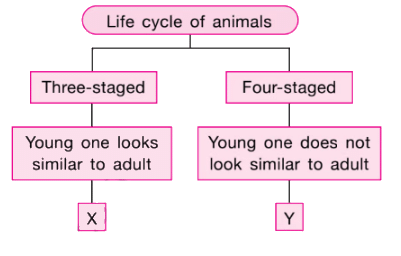 (a) Mosquito / Cockroach
(a) Mosquito / Cockroach
(b) Cockroach / Mosquito
(c) Mosquito / Frog
(d) Cockroach / Grasshopper
 View Answer
View Answer 
Ans: (b)
- The question asks for the correct representation of X and Y based on a classification chart.
- Option (b) Cockroach / Mosquito is the correct answer, indicating the relationship between these two insects.
- Understanding the classification helps in identifying how these organisms are grouped based on their characteristics.
- Insects like cockroaches and mosquitoes belong to the same class but differ in their specific traits and behaviors.
Q29: Soil formation takes place as a result of ___________ acting on rocks over an extended period.
(a) Wind
(b) Rain
(c) Heat of the Sun
(d) All of these
 View Answer
View Answer 
Ans: (d)
- Soil formation is a gradual process that involves the breakdown of rocks.
- This breakdown is influenced by various natural elements such as wind, rain, and the heat of the sun.
- Each of these factors contributes to the weathering of rocks, leading to the creation of soil.
- Therefore, the correct answer is All of these as they all play a role in soil formation.
Q30: The standard unit of measuring capacity is ___________.
(a) Gram
(b) Kilometre
(c) Litre
(d) Celsius
 View Answer
View Answer 
Ans: (c)
- The standard unit for measuring capacity is the litre.
- Grams measure weight, while kilometres measure distance.
- Celsius is a unit for measuring temperature, not capacity.
- Thus, the correct answer is litre, which is commonly used for liquids.
Achiever’s Section
Q31: A group of students conducted an experiment. They filled three identical beakers X, Y, and Z with equal amounts of water and placed them in three different locations. After 2 hours, they noted the results as shown in the provided table. However, they neglected to specify the locations of the beakers. Based on the results, which of the following options accurately identifies the locations where the beakers were placed? 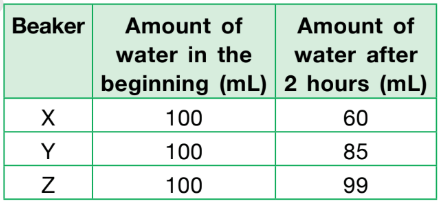
(a) Open sunny area / Classroom / Closed cupboard
(b) Closed cupboard / Classroom / Open sunny area
(c) Classroom / Closed cupboard / Open sunny area
(d) Open sunny area / Closed cupboard / Classroom
 View Answer
View Answer 
Ans: (a)
- The experiment involved three beakers placed in different locations: an open sunny area, a classroom, and a closed cupboard.
- The beaker in the open sunny area likely experienced the most evaporation due to sunlight and heat.
- The classroom would have moderate conditions, while the closed cupboard would have the least evaporation.
- Thus, the correct identification of the locations based on the results is: Open sunny area / Classroom / Closed cupboard.
Q32: Study the following actions that were carried out.
1. Pushing a 2 kg skateboard on a flat rough ground over a distance of 2 m.
2. Pushing a 2 kg bag of flour on a flat rough ground over a distance of 2 m.
3. Pushing a 5 kg sack of rice on a flat rough ground over a distance of 2 m.
4. Pushing a 5 kg sack of onions up a rough slope over a distance of 2 m.
Arrange the above actions according to the amount of force required to carry out the actions, starting with the action that uses the least force.
(a) 1, 2, 4, 3
(b) 4, 3, 2, 1
(c) 1, 2, 3, 4
(d) 4, 1, 2, 3
 View Answer
View Answer 
Ans: (c)
- The force required to push an object depends on its weight and the surface it is on.
- Actions 1 and 2 involve pushing 2 kg objects on a flat surface, which requires the least force.
- Action 3 involves a 5 kg object on a flat surface, needing more force than actions 1 and 2.
- Action 4 requires the most force because it involves pushing a 5 kg sack up a slope, which adds to the effort needed.
Q33: Refer to the given plant and select the correct statement regarding it.
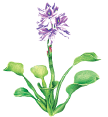
(a) The given plant is rooted in the soil at the bottom of the pond.
(b) The given plant can float freely on the surface of ponds and lakes.
(c) The given plant does not possess stomata.
(d) None of the above.
 View Answer
View Answer 
Ans: (b)
The given plant is a water hyacinth. This plant can float freely on the surface of ponds and lakes.
Q34: Refer to the given flowchart and select the option that correctly identifies the plants P, Q, R and S.
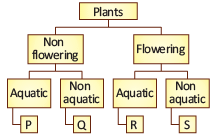
(a) R : Bryophyllum, S : Sundew
(b) S : Gulmohar, Q : Fir
(c) P : Duckweed, R : Arrowhead
(d) P : Water hyacinth, Q : Pine
 View Answer
View Answer 
Ans: (b)
P can be Hydrilla, Q can be Fir, R can be Lotus and S can be Gulmohar.
Q35: Refer to the given picture of a plant with some of its parts labelled as P, Q and R.
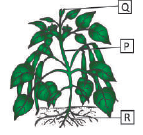
In the absence of part _________, the plant cannot reproduce whereas in absence of part __________, the plant cannot make food.
(a) Q , P
(b) R, Q
(c) P, R
(d) P, Q
 View Answer
View Answer 
Ans: (a)
Leesa are needed to make food and flower helps in reproduction in plants.
|
57 videos|76 docs|59 tests
|
FAQs on Science Olympiad Previous Year Questions - 1 - Science Olympiad Class 4
| 1. What topics are typically covered in the Class 4 Science Olympiad? |  |
| 2. How can I prepare effectively for the Class 4 Science Olympiad? |  |
| 3. What is the format of the Class 4 Science Olympiad exam? |  |
| 4. Are there any specific study materials recommended for the Science Olympiad? |  |
| 5. What is the importance of participating in the Science Olympiad for Class 4 students? |  |
















